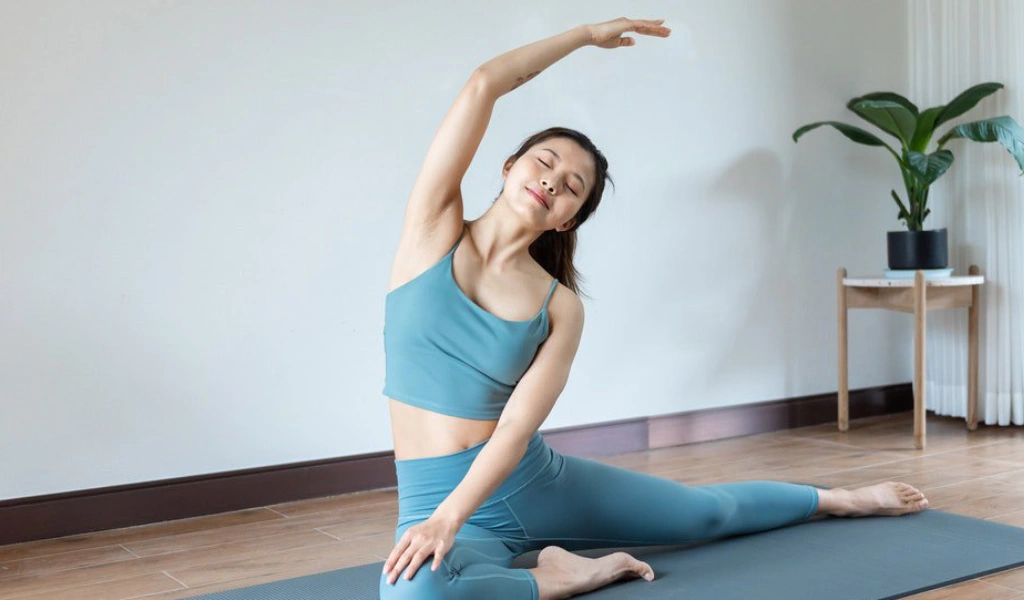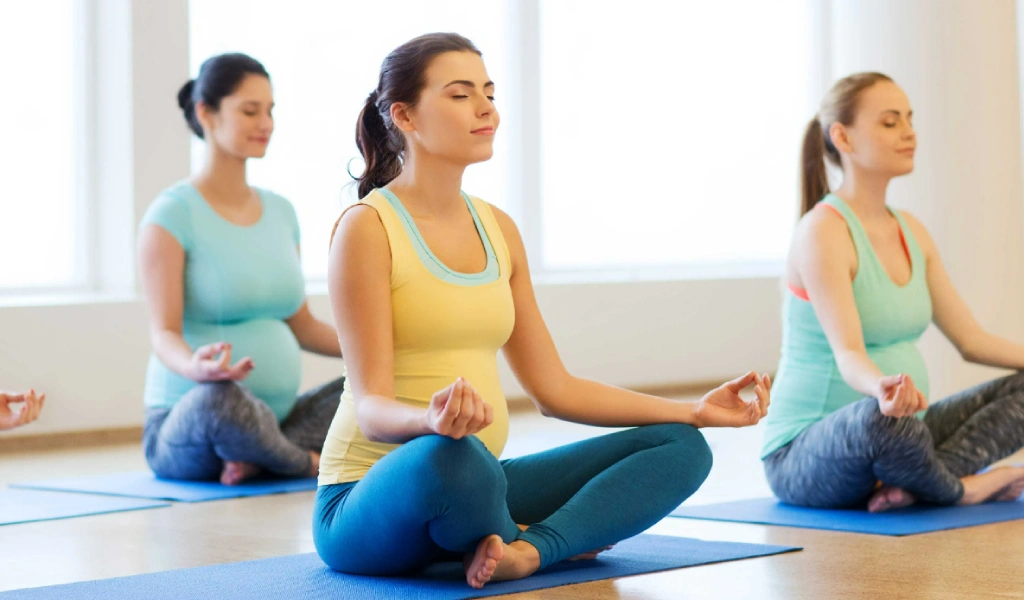Yoga is a comprehensive method for maintaining health, and specific poses can potentially enhance fertility.
Yoga could enhance your ability to conceive. It is true. The modern age of shifting lifestyle habits and reduced physical activity could impact fertility as well. To improve fertility and increase the likelihood of conception, consider practicing yoga.
While fertility yoga cannot guarantee successful conception, it may enhance the likelihood of becoming pregnant. Keep reading to learn about how fertility yoga can assist with conception and some specific yoga poses that you can practice to improve your chances of getting pregnant.
What Is Fertility Yoga?
Fertility yoga consists of a sequence of yoga postures designed to lower stress and cleanse the body. The poses target the pelvic area and promote better blood circulation. By increasing blood flow to the uterus, hips, abdomen, and heart, these poses can aid in reducing stress and improving overall health. Additionally, they work to strengthen the body and potentially enhance fertility.
How Yoga Could Enhance Your Ability to Conceive?
Yoga experts believe that while there is no proven cause-and-effect relationship between yoga and fertility, practicing yoga may have a positive impact. Scientific evidence does not support the idea that yoga can directly address infertility problems. However, it is thought by some that yoga can enhance fertility.
Improve blood flow to the lower abdominal region to stimulate the reproductive system.
Increased circulation leads to a greater delivery of nutrients and oxygen to the reproductive organs, which in turn helps alleviate constricted blood vessels and facilitates the flow of blood to the pelvic floor muscles.
Control the endocrine system that secretes different hormones, such as those specific to females.
Decrease the production of adrenaline and cortical hormones that cause stress, leading to infertility.
Practicing yoga alone does not ensure a resolution to fertility issues. It is recommended to seek advice from a medical expert if you are experiencing challenges with conception. A healthcare provider will provide a proper evaluation and recommend necessary medical treatments. In addition, you may opt to include yoga as part of your treatment regimen.
Top Fertility yoga positions that can enhance your likelihood of becoming pregnant
Below are a series of breathing exercises (pranayama) and meditation techniques, as well as physical postures (asanas) that have the potential to enhance your reproductive health. It is important to practice these asanas under the guidance of a qualified instructor and in a safe environment. Before starting these practices, it is advisable to consult with your physician.
1. Bhramari Pranayama (Bee Breath)
Soothes the nerves near the brain and forehead. The gentle vibrations can help alleviate feelings of stress, anger, and anxiety while enhancing mindfulness.
Steps to do:
- Find a comfortable position in a location that is well-aerated and keep your eyes shut.
- Use your thumbs to cover your ears.
- Position your pointer finger above your forehead.
- Use gentle pressure on the sides of your nose using your other fingers.
- Inhale and exhale. Lightly touch the earlobes while producing a buzzing noise similar to a bee.
- Continue making the sound as long as you feel comfortable and then repeat it.
Caution:
- Do not engage in practice if you have a severe ear infection or while lying down.
- Place your thumb on the cartilage of the ear, but avoid placing it inside the ear canal.
- Keep your mouth closed when producing the humming noise.
- Do not apply force on your facial skin.
2. Nadi Shodhan pranayama (Alternate nostril breathing)
Promotes overall health by addressing your physical, mental, and emotional needs and aids in relieving feelings of stress, depression, and negativity.
Steps to do:
- Make sure to sit comfortably with your back straight.
- Place your right ring finger and pinky finger on the left nostril, with your thumb on the right nostril.
- Use your ring and pinky fingers to open or close the left nostril, and use your thumb for the right nostril.
- Inhale through the left nostril and exhale through the right nostril. Then, breathe in through the right nostril and breathe out through the left nostril.
- Continue doing it as long as you feel at ease.
- Finally, you can now relax and gently open your eyes.
Caution:
- If you have had surgery on your heart, stomach, or brain, it is not recommended to engage in physical activity.
- Do not do it right after eating. Wait for at least four hours before engaging in that activity.
- Do not exert pressure on your breath and allow it to flow naturally and softly.
- Avoid applying any force on the forehead and nose; instead, gently place your fingertips on those areas.
3. Paschimottanasana (Seated forward bend)
This pose helps to stretch the muscles in the lower back, hips, and hamstrings. It also encourages blood flow to the uterus and ovaries, which can assist in the implantation of an embryo and alleviate feelings of stress and depression.
Steps to do:
- Take a seat on the ground with your legs fully extended.
- Place your hands on your thighs.
- While breathing in, extend your arms and lift them directly above your head.
- When you breathe out, make sure to maintain a straight back and slowly lean forward while reaching for your toes.
- Move your head towards your knees to make contact.
- Count five numbers while you refrain from breathing in this posture.
- Return to the starting position by straightening your body and placing your hands on your thighs.
Caution:
- If you have abdominal ulcers, asthma, diarrhea, sciatica, or slipped disc conditions, it is advised not to engage in practice.
- When you bend forward, use the strength of your lower back muscles rather than your spinal muscles.
- As you extend your arms from the shoulders towards your toes, do not push yourself too hard to touch the toes.
4. Hastapadasana (Standing forward bend)
By stretching the muscles in the back, it aids in enhancing blood circulation to the nervous system and pelvic region. It also alleviates stress in the abdominal area and lengthens the muscles along the spine.
Steps to do:
- Keep your back straight and keep your legs close together.
- Inhale deeply and lift your hands above your head.
- During exhalation, lean your body forward so that your back is stretched to its fullest extent.
- Attempt to touch your ankle with your hand while ensuring your knees remain straight.
- Maintain this posture for a brief moment.
- Take a deep breath and slowly return to an upright stance.
Caution:
- Avoid practicing if you have any injuries in your lower back, neck pain, spondylitis, spinal issues, or back problems.
- Do not engage in this activity while menstruating.
5. Janu Shirshasana (One-legged forward bend)
Flexibility is increased in the spine, tension is released from the lower back, the abdominal organs are toned, and the hamstrings and calves are stretched by this practice.
Steps to do:
- Please have a seat with your right leg extended in front of you.
- Bend your knee on the left side and try to bring the heel as close to the groin as you can.
- Position the bottom of your left foot against the inner thigh of your right leg.
- When you breathe in, lift both arms overhead and stretch upwards. Rotate slightly to the right at the waist.
- Bend forward with your back straight and attempt to grasp the right foot’s toes while exhaling.
- Relax your back and avoid pushing your body too far. Stay in this position for as long as you can until you feel at ease.
- Go back to the starting position by raising the head and letting go of the hands.
- Repeat the same action on the opposite side by switching the placement of the legs.
Caution:
- If you have asthma, diarrhea, hernia, or a knee injury, refrain from participating in the activity.
- Do not perform any physical activity while on your period.
6. Baddha Konasana (Butterfly pose)
This particular yoga pose is recognized as an effective way to open up the hips by stretching the groin, inner thighs, and knees. As a result, it may improve blood circulation to the pelvic area and eliminate harmful energy and toxins stored in these regions.
Steps to do:
- Have a seat with your legs extended in front of you.
- Curve your knees for the bottoms of your feet to make contact with one another.
- Bring the feet closer together by grasping the toes with your hands.
- Take regular breaths and move your knees and thighs in a fluttering motion, similar to how a butterfly moves its wings.
- Gradually raise and lower the speed, and you will sense a pulling sensation in the pelvic area and inner thighs.
- Return to the starting position while keeping your legs extended.
Caution:
- Refrain from doing this position if you have injured your knee or groin.
- If you have high blood pressure or heart issues, it is best to refrain from this activity.
7. Viparita Karani
This position helps reduce stress in the lower body by increasing blood circulation to the pelvic area. It also stretches the hamstrings and lower back, which can improve the likelihood of becoming pregnant.
Steps to do:
- Lay on the ground and extend your back and legs in a straight position.
- Lift your legs slowly until they are at a 90-degree angle and keep them straight pressed against the wall.
- Take a deep breath while holding this position.
- Perform the position 5 to 8 times consecutively.
Caution:
- Avoid exercising during your period or if you suffer from hypertension.
- Refrain from assuming the stance if you have significant eye issues like glaucoma.
- If you have neck pain, you can relieve it by putting a folded blanket or pillow under your head.
8. Balasana (Child’s pose)
It has a calming effect on the brain and helps reduce stress and fatigue. This exercise works to elongate and build strength in the muscles of the back, hips, thighs, and ankles. It also targets the pelvic area and promotes better blood circulation.
Steps to do:
- Get down on the ground and rest on your heels with your toes touching.
- Maintain a hip-width distance between your knees as you slowly lean forward.
- Extend your arms in front of you with your palms facing down.
- Stay in this stance for as long as it feels pleasant for you.
Caution:
- If you have a knee or back injury, avoid participating in physical activity.
- If you have diarrhea, high blood pressure, or ear or eye infections, it is best to refrain from doing the pose.
- If you feel uneasy resting your head on the ground, you can utilize a cushion for additional comfort.
9. Salamba Sirshasana (Supported headstand)
This particular yoga position is known for its high level of difficulty. Doing this pose involves turning the body upside down, which can relieve pressure on the heart. Balancing the head while bearing the weight of the entire body can help stimulate the brain and prompt the body to release more hormones. Mastering this yoga pose involves intense concentration and could potentially have beneficial effects on fertility.
However, this task can only be accomplished by those who are skilled in the subject or under the guidance of an expert.
Steps to do:
- Start by laying your head on a pillow or a comfortable bed.
- Place your palms together on the ground, with your forearms resting on the floor and your head positioned between your hands.
- While breathing in, bring yourself up from the floor by shifting your feet towards your head, lifting your heels, and sliding your shoulder blades downwards towards your spine.
- Lift your legs together while exhaling. Keep your legs straight with your toes pointing upwards; avoid bending your knees or back.
- Stay in this pose for ten seconds or until you feel at ease.
- Return to the starting position by lowering your legs and transitioning into the Child’s pose.
Caution:
- Avoid performing the pose if you have issues related to your heart, blood pressure, kidneys, neck, or eyes.
- Avoid doing this pose right after completing a series of strenuous exercises since the physical exertion may cause toxins to be released from the body and potentially travel to the brain.
- Refrain from engaging in activities while menstruating.
- Pause the yoga posture if you start to feel a headache, dizziness, or irregular heartbeats.
- Wait for some time before doing it right after you finish eating.
- If you haven’t had enough practice, make sure your trainer is present and also pad the area around you.
10. Salamba Sarvangasana (Supported shoulder stand)
Similar to the pose known as the supported headstand, this position involves balancing the body on the shoulders rather than the head. It helps relax the pelvic area and enhance blood circulation to the uterus. Additionally, it aids in stimulating the thyroid gland.
This also requires oversight by a professional.
Steps to do:
- Lie down on your back and gently raise your legs upwards towards your head.
- Curve your elbows and bring your hands towards your lower back.
- Keep extending your legs towards the ceiling to align your shoulders, hips, knees, and heels in a straight line.
- Use your hands to support your lower back and raise your hips.
- Raise your chin slightly to direct your gaze towards the navel.
Caution:
- Avoid doing the pose if you are experiencing a headache, high blood pressure, diarrhea, a neck injury, or menstrual issues.
- Place a cushion or layers of folded blankets under your neck to avoid straining your muscles.
- Refrain from doing it while on your period.
11. Setu Bandha Sarvangasana (Bridge Pose)
This pose involves lifting the pelvic region, which can improve blood and energy circulation to the ovaries and uterus. It is also beneficial for activating the thyroid gland.
Steps to do:
- Lie down on a mat with your knees bent and your feet flat on the ground, making sure your knees and ankles are in a straight line.
- Position your hands with palms facing down next to your body.
- As you breathe in, raise your hips and back up from the ground.
- Use your shoulders, arms, and feet to bear your body’s weight.
- Ensure that your chin makes contact with your chest.
- Contract your glutes and ensure your thighs are aligned with the ground.
- Stay in this position for as long as you feel at ease, taking slow breaths.
- Let go of the position as you breathe out.
Caution:
- Avoid performing the position if you experience pain in your knees, or back, or have sustained a back injury.
- Avoid shifting or inclining your head to the right or left.
- Shoulder injury or neck pain should be avoided when engaging in this activity.
12. Bhujangasana (Cobra pose)
Enhancing circulation to the pelvic area, elongating the spine, and expanding the chest can help alleviate stress and anxiety through the stimulation of the uterus and ovaries.
Steps to do:
- Lie on your stomach with your legs together and hands by your sides.
- Slowly raise your upper body by pressing down with your hands. Stretch backward as far as possible.
- Stay in this position for about 30 seconds while taking slow and deep breaths.
- Return to the original position by breathing out gradually.
Caution:
- If you have any injuries in your shoulders or arms, do not engage in the pose.
- If you have a lower back issue, it is recommended to refrain from bending forward completely.
- If you have a hernia, peptic ulcers, hypothyroidism, or intestinal tuberculosis, it is best to avoid this.
13. Supta Baddha Konasana (Reclining bound angle)
The activity of stretching and relaxing the pelvic area enhances blood circulation to the reproductive organs, while also stimulating the nervous system and reducing stress.
Steps to do:
- Recline on the ground while keeping your spine aligned.
- Raise your hands above your head, with your palms pressed together and facing upwards.
- Bend your knees so that the soles of your feet touch each other, facing each other, to create a butterfly shape.
- Stay in this posture for approximately five minutes, then gradually return to the starting position.
Caution:
- Avoid performing this position if you are experiencing discomfort or have an injury in your lower back, knee, or groin.
- If you are on your period, it’s best to refrain from it.
- To provide additional support, place a blanket under your thighs.
14. Malasana (Squat or Garland pose)
Opening up the hips can help boost your metabolism and tone the pelvic floor, potentially improving your sex life.
Steps to do:
- Assume a relaxed squat stance with legs spread wider than the width of the hips.
- Your knees and feet should be facing the same direction.
- If your heels do not touch the floor, you can place small rolled-up towels or cushions under them for additional support.
- Utilize the assistance of the muscles in your back and core to maintain an upright sitting position.
- Join your hands together and push your elbows towards the inner thighs.
- Remain in this position for 30 seconds before slowly transitioning back to a standing position.
Caution:
- Refrain from attempting this position if you have any issues with your knees, hips, or lower back.
- Place a block under the hips to provide support and alleviate any discomfort or pressure in the knees.
- If you are unable to keep your heels straight on the floor, you can place a folded or rolled blanket underneath them.
15. Utkata Konasana (The Goddess pose)
Strengthens the muscles in your hips, groin, and core. Enhances the flow of energy to the hip and pelvic regions, which can help increase stimulation to the reproductive organs.
Steps to do:
- Create a broad stance by positioning your legs wider than the width of your hips.
- Ensure that your heels are facing inward and your toes are pointing outward, positioning your feet at a 45-degree angle.
- Bend your knees towards your toes to lower yourself into a deep squat.
- Put your hands in the air with your palms directed towards the front.
- Bring your tailbone down and hold this position for approximately 30 seconds.
Caution:
- If you have recently injured your shoulders, legs, or hips, avoid doing this pose.
- This pose may not be appropriate for individuals with hypertension because it creates internal heat.
- While spreading your legs apart, make sure not to exceed your physical limits.
16. Shavasana (Corpse pose or Yogic sleep)
Improves your mental state and reduces levels of stress and anxiety. While it does not affect your reproductive system, it helps in relaxation and cooling down after a yoga session.
Steps to do:
- Assume a supine position with your hands resting beside you and legs positioned slightly wider than the width of your hips.
- Face your palms upwards and shut your eyes.
- Take a slow breath in, pause briefly, and then exhale slowly.
- Maintain this posture for a duration of three to five minutes before letting go of the position.
Caution:
- Perform it in a peaceful environment.
- Avoid falling asleep in this position as it could disrupt the equilibrium between relaxation and breathing rhythm.
17. Mandukasana (Frog pose)
An advanced yoga position that targets the core, lower back, knees, hips, thighs, and inner thighs. Enhancing posture, alleviating back discomfort, increasing flexibility and focus, and promoting the relaxation of hip muscles.
Steps to do:
- Assume a tabletop position with your arms parallel to your shoulders and your knees positioned under your hips.
- Slowly separate your left and right knees outwards as much as your body permits.
- Rotate your feet outward and extend your ankles until the inner foot, inner ankle, and knee make contact with the ground.
- Lower yourself down onto your forearms, ensuring they are flat and in line with your palms on the floor.
- Gently extend your arms forward while gradually lowering your upper abdomen, chin, and chest towards the floor.
- Slowly and gently separate your knees while keeping them on the ground. Hold this posture for 30 seconds before returning to the original position.
Caution:
- Take a deep breath as you transition from one position to another and exhale while pausing in between transitions.
- Make sure to stretch only to the extent that your body permits. Avoid putting too much pressure on your lower body.
- Make sure to activate your core muscles and keep your spine in a neutral position. To increase stability, place a foam roller beneath your abdomen.
- Pause in each pose for a few breaths before transitioning to the next pose.
- While stretching your ankles, it is recommended to use a knee-length blanket to alleviate any tension.
Yoga provides various health advantages, including enhanced fertility. Engaging in fertility yoga can enhance blood circulation to the reproductive system, encouraging stimulation and hormone regulation. Nonetheless, relying solely on one method is not a guaranteed way to boost fertility. Therefore, it is advisable to incorporate consistent fertility yoga practice with a nutritious diet and a health-conscious lifestyle for better outcomes. Also, consult a medical professional to uncover any potential fertility issues that may necessitate medical intervention.
Key Pointers of ‘Fertility yoga positions that can enhance your likelihood of becoming pregnant’
- Engaging in fertility yoga may improve the likelihood of becoming pregnant.
- It assists in reducing stress levels and enhancing circulation across the entire body.
- Some commonly practiced yoga poses to enhance fertility are Paschimottanasana, Baddha Konasana, and Balasana.
- It is essential to be cautious and mindful when practicing yoga to prevent any potential injuries.


















